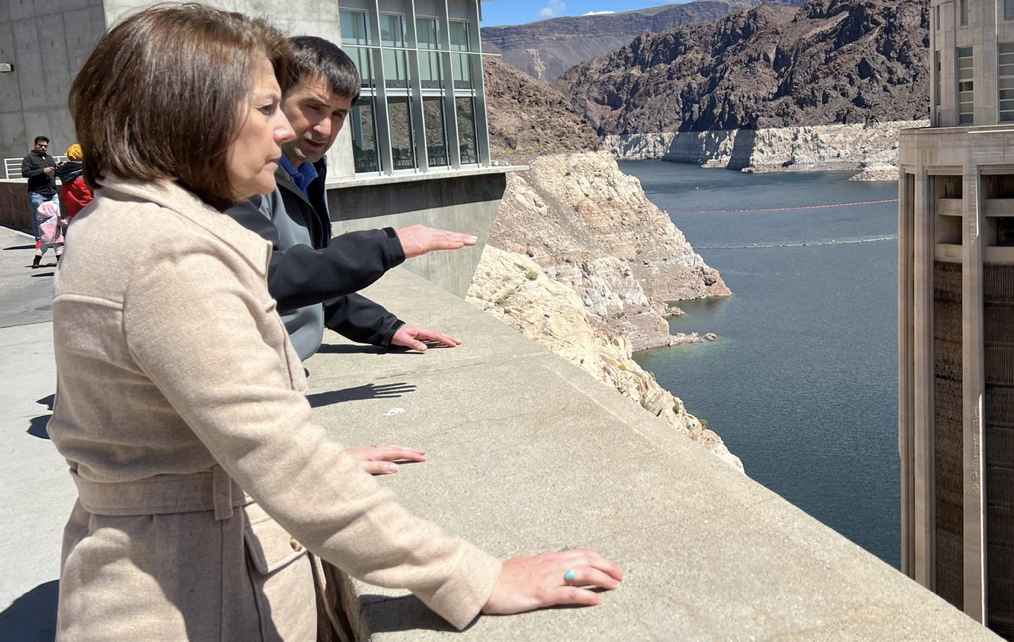
Sen. Cortez Masto looks out over Hoover Dam over concerns about drought impacting Lake Mead (Photo: @SenCortezMasto)
Cortez-Masto Backs New Water Pipeline Through Conservation Area
The $2.5 billion project would be funded by ‘Southern Nevada water users’
By Megan Barth, June 20, 2023 3:48 pm
Senator Catherine Cortez Masto has introduced S. 2042, which would expand the boundaries of the Sloan Canyon National Conservation Area for the construction of a proposed $2.5 billion Horizon Lateral water pipeline, a pipeline projected to protect water access for more than 1 million Nevadans and would provide backup to an existing pipeline, constructed in 1999, and now serves 1 million people. According to the Southern Nevada Water Authority, the $2.5 billion project would be funded by “Southern Nevada water users.”
The Horizon Lateral water pipeline project would protect water access for more than 1 million Nevadans while also protecting our incredible desert landscape in the Sloan Canyon.
I'll always work to bring common sense solutions home to our state.https://t.co/uQjtPcwGfa
— Senator Cortez Masto (@SenCortezMasto) June 20, 2023
“This legislation will increase the capacity of our entire water system in the (Las Vegas) valley while protecting our unique ecosystems and the residents and businesses in Henderson,” Cortez Masto said in a statement.
According to the AP:
Federal funds are not part of the $2.5 billion project cost, and construction is not expected to begin for at least two years, said Bronson Mack, water authority spokesman. Construction is not expected to disturb the desert surface, although survey work would be conducted.
Southern Nevada water users will fund the work, Mack said, and the pipeline won’t increase the amount of water the region draws from the drought-depleted Lake Mead reservoir behind Hoover Dam. The Las Vegas area, in the Mojave Desert, is home to 2.4 million residents and attracts some 40 million visitors per year. It is almost completely dependent on water from the Colorado River.
“We’re still in the permitting phase,” Mack said. “We expect about two years of engineering design work and about two years for construction.”
Due to the sensitive location of the proposed construction, environmental groups are expected to challenge the project. According to the Bureau of Land Management: “The 48,438 acre national conservation area forms the southern mountainous skyline of Las Vegas and the City of Henderson. The Sloan Canyon Petroglyph Site is one of the most significant, scenic, and important cultural resources in southern Nevada having more than 300 rock art panels, and nearly 1,700 designs representing native cultures dating from Archaic to historic era.”
As reported by The Globe, this new pipeline could be aligned with Clark County’s development efforts to “Transform Clark County”–a 400 plus page master development plan which reworked and rewrote zoning ordinances and regulations to transform Clark County into an “equitable, diverse, and climate-resilient’ county.”:
This past June, Cortez Masto pushed for expanded development by submitting legislation to sell off 42,000 acres of public lands to spur new development in the town that borders Lake Mead through S. 567; a bill that will sprawl an area the size of Miami or St. Louis alongside the existing Vegas footprint and, in part, “expands eligible uses of, the limited transition area located in the city of Henderson.”
According to population estimates used to justify the bill, the Southern Nevada Economic Development and Conservation Act hopes to draw more than 820,000 new residents to Southern Nevada’s patch of the Mojave Desert in the next 40 years. That means there will be hundreds of thousands of new consumers of the Colorado River in a fast-warming region in the nation’s driest state.
Masto’s legislation comes on the heels of legislation signed by Governor Joe Lombardo which empowers the Southern Nevada Water Authority to restrict water usage in “single family homes” (apartments and hotels excluded) if the federal government slashes Nevada’s share of the Colorado river below a certain threshold. With his signature, Nevada became the first state in the nation to empower a local water agency to limit and enforce water usage in response to the federal governments actions, and as a remedy to conserve water in a county where massive multi-unit apartment buildings and new developments of single family homes are challenging natural resources.
- Illegal Alien Identified As Wrong-Way Driver in Fatal Crash That Killed LVMPD Officer - December 23, 2024
- Senator Rosen Joins Letter Raising Concerns About Pete Hegseth’s Nomination - December 20, 2024
- NV SOS Launches Four Investigations Into 2024 Election Violations - December 20, 2024




